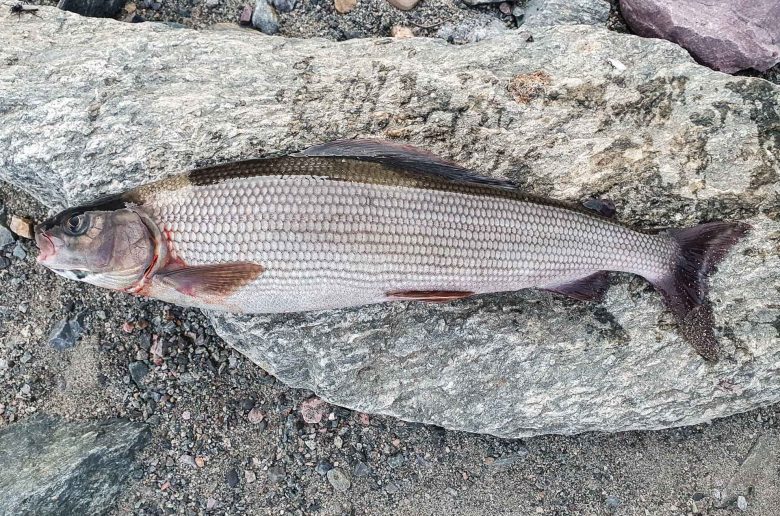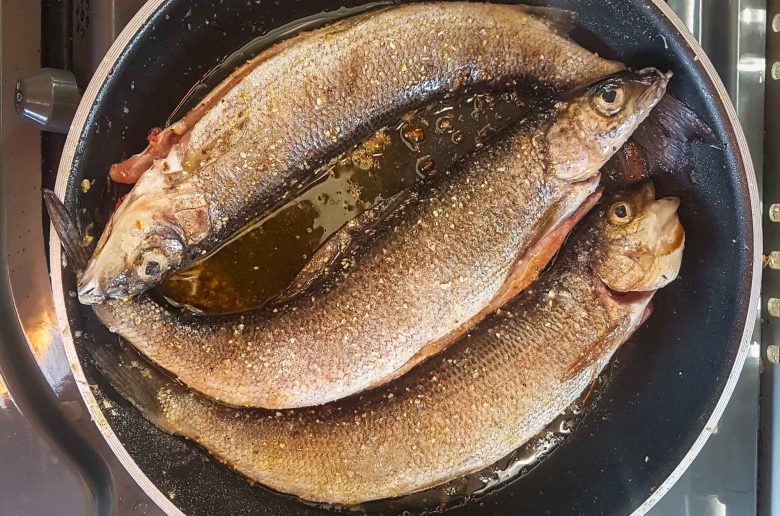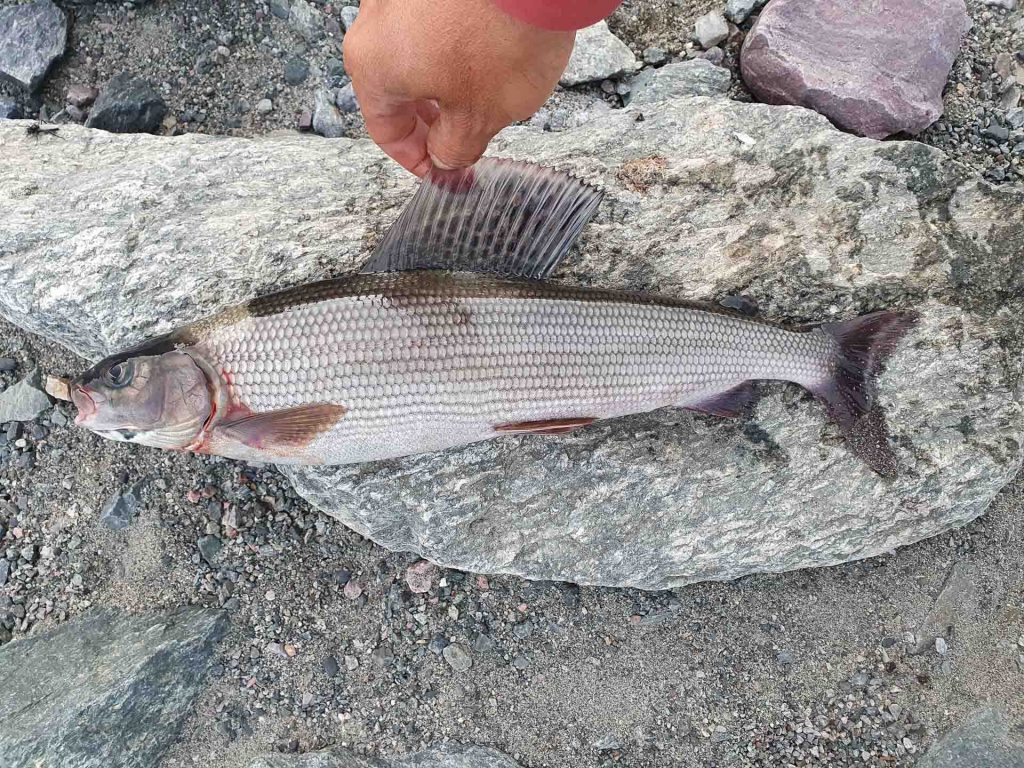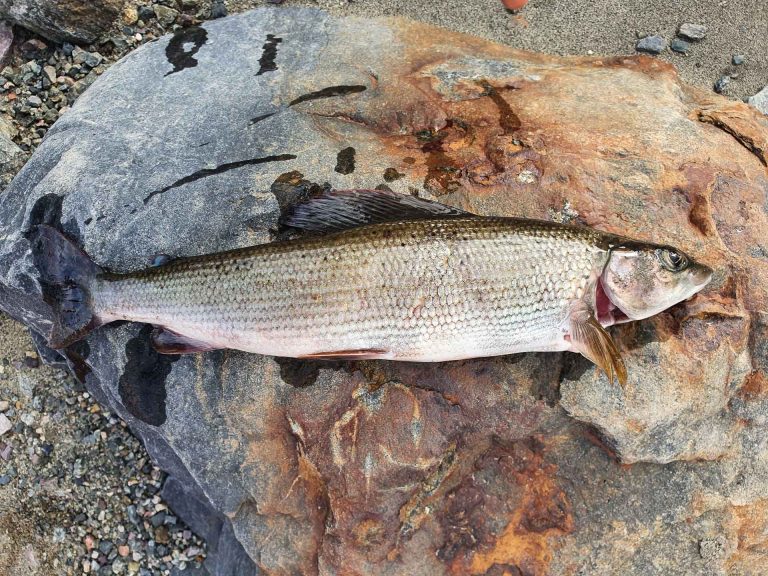(nor, swe.: harr; fin.: harjus; dt.: Äsche)

Grayling ( Thymallus thymallus ) is a species of fish that lives in cool and oxygen-rich inland and brackish waters. This freshwater fish belongs to the salmon family. Its body is covered with silver-greyish scales topped with its distinctive feature – a shimmering dorsal fin also called “the sail”. Grayling prefer cold, clean, running riverine waters and they are found throughout the northern parts of Scandinavia. Some of the best fishing grounds for grayling can be found in Finnish and Swedish Lapland. Specimen around one kilo are considered a trophy fish but catches up to 2 kg are caught every year.
Fishing and Fishing Methods
The good thing about graylings is that they are mostly in good mood to bite. In our experience fly-fishing works much better than spin fishing on this fish. If you are just starting out your fly-fishing career fishing for grayling in Lapland is one of the best ways to do so. You can even repurpose your spinning rod for fly-fishing with some simple tweeks. Season opening is usually around the end of May and wet flies are the way to go during this time. Later in the summer dry flies work best. If you are not looking for the biggest fish, really small black dry flies can bring you a lot of happiness and food especially during summer. If you stick to spin fishing you can use smaller spinner or spoons and jigs. The best grayling areas for the purists are in the wilderness far off the beaten path in the backcountry of Lapland.

Spinning
- Spinners (6 –12 grams)
- Spinners (0 – 5 grams)
- Spoons
- Jigs
Fly Fishing
- Streamers
- Nymph
- Dry Fly
- Wet Fly
Angling Records
- Finland: 2,47 kg
- Sweden: 2,85 kg
- Norway: N/A
Other information on Grayling
Appearance and size
Grayling is silver-sided and differs from other salmonids by its large dorsal fin. Its back, chest, belly, stern and tail fins are pale reddish-brown with blue spots and as a salmonid it has an adipose fin. The dorsal fin is remarkably large, tall and multicolored. The lower and upper edges of the scales are darker than the central parts, giving the impression of a longitudinal stripe on the sides. The abdomen is pale and the back dark. It has a fairly small head and gills, small teeth and a slender body.
The coloring may also be brownish, purple or greenish and the color of the fins may also be bluish-grey. The young fishes have dark spots on the sides, like trout.
Typically, grayling is 20-50 cm long and weighs 300-900 g. It can live to be 15 years old. The world record is 4.30 kg 72 cm, the Finnish record is 2.47 kg and the Swedish record is 2,85 kg. However, individuals over 4 kg are reported to have been caught from different parts of Scandinavia.

Behavior
Grayling has five different ecological forms depending on habitat and migrating behaviour: local river grayling, local lake grayling, lake or sea migratory grayling, and local sea grayling. With the exception of spawning time, grayling is terretorial and does usually not migrate of more than 3 kilometres.
The fish overwinters in deep, slow-flowing areas and for the summer it moves to a stronger current. Lake grayling thrives on reefs and beach areas with gravel and rock. After spawning, the migratory grayling swims back into the sea, where it resides mostly on rocky outer shores and deep-sloped roaches.
During springand summer, the grayling moves between the water surface and a depth of 10 meters. It thrives in deep waters from early summer, but moves to shallower waters over the summer and fall. During the ice cover grayling move often closer to the ice suface.
Grayling reside in flock-like groupings and each individual has their own small territory, usually around a rock or some kind of water plant. The grayling expresses its territory to the intruder by extending its dorsal fin.
Increase
Grayling reach sexual maturity at the age of 3–6 years and 30–39 cm in length. Spawning begins in the spring when the water temperature exceeds 4 ° C. It requires a base of sand, gravel and stones in shallow waters, free of aquatic vegetation or other organic matter.
Grayling do not dig the actual spawning nests, but as a result of the tail movements of the spawning fish, the eggs are buried in the gravel to a depth of about 4 to 8 cm. The male then drives the female out of its territory. Females spawn with several males. The spawning is at its busiest in the afternoon during which period the fish usually does not feed.
Eggs develop in gravel about 2 to 5 weeks, after which the hatchlings emerge with a length of about 10 to 12 mm. The young fishes prefer shallow, slow flowing, and rocky environments. When the young fish grow to more than 4 cm in length, they disperse from the flocks of hatchlings and make their own way.
Food
In the juvenile stage, the diet consists of zooplankton and insect larvae. As it grows, molluscs, crustaceans, insects and their larvae, as well as small fish or roe and litter of other salmonids gets part of its diet. Grayling prey on food throughout the daylight period.
Distribution
Grayling is a viable species. It is present in Europe, scattered mainly in rivers in Great Britain and France, central and eastern regions, northern Italy. The Gulf of Bothnia is known to have the only stock in the world, which spawns in brackish water. In Sweden, Finland and Norway the best fishing grounds are in Lapland.
Water quality
Grayling occurs in cool, clear, low-nutrient and oxygen-rich waters with clean sandy and gravel bottoms suitable for reproduction.
Temperature
Grayling thrives in water with a temperature of 0-24 ° C. At temperatures above 25 ° C it dies. It grows best when the water temperature is 4-18 ° C. The temperature requirements for eggs are stricter than for adult fish: the eggs die if the water temperature is below 3 ° C or above 18.5 ° C. The ideal temperature for egg development is about 4-8 ° C. Egg mortality increases rapidly when the water temperature exceeds 13 ° C. The ideal growth temperature for young pups is about 17 ° C.
Fishing and use
The flesh of the grayling is light in color, tasty, with a fat content of 4 to 8% and smells mildly of thyme, hence the Latin name “thymallus”. It is caught as food fish with rods and nets.
In Finland, fishing for grayling is completely prohibited in the sea, and in inland waters south of 67° N from 1 April to 31 May. There are also undersizes for grayling usually around 35 cm south of latitude 67° N and north of it is 30 cm. Latitude 67 ° N is located about 50 km north of the Arctic Circle. Every year there are several millions of grayling planted throughout the North.
Sea-spawning grayling
Sea-spawning grayling occur only in the Baltic Sea in the coastal areas of the Gulf of Bothnia. It has been common in large areas there since the 1960s. Today, it is most commonly found in the Bothnian Bay, the Ouran and Vaasa archipelagos, and the Swedish coast. The habitat of the sea grayling is narrow and they are not known for long migration routes. Today, it is an extremely endangered species on the verge of extinction.
Sea-spawning grayling seek to spawn on shallow, barren and clear-water beaches at the time of ice departure. The spawning environment is vegetation-free rock and gravel bottoms near the outer islands, islets, ravines and underwater spines.

